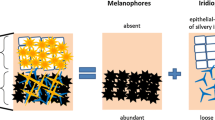Abstract
One branch of ecotoxicology has focused on identifying genetic markers in fish that are associated with susceptibility to toxic compounds. In laboratory studies, a common approach has been to compare the genetic variation in fish that die first in time-to-death studies to that found in fish that live longer or survive the exposure. Studies of this kind would benefit from the ability to identify living individuals as susceptible, as these individuals could then be used to answer currently unanswerable questions. The purpose of this mini-review is to suggest that post-exposure swim performance can be used to sublethally discriminate between susceptible and resistant individual fish after these fish have been exposed to environmental stressors, particularly heavy metals.
Similar content being viewed by others
References
Beamish, F.W.H. (1978). Swimming capacity. InW.S. Hoar and D.J. Randall (eds) Fish Physiology, Vol. 7, pp. 101–87. NY, USA: Academic Press.
Berry, C.R. Jr. and Pimentel, R. (1985). Swimming performance of three rare Colorado River fishes. Trans. Am. Fish. Soc. 114, 397–402.
Beitinger, T.L. and McCauley, R.W. (1990). Whole-animal physiological processes for the assessment of stress in fishes. J. Gt. Lakes Res. 16, 542–75.
Chagnon, N.L. and Guttman, S.I. (1989). Differential survivorship of allozyme genotypes in mosquitofish populations exposed to copper or cadmium. Environ. Toxicol. Chem. 8, 319–26.
Diamond, S.A., Newman, M.C., Mulvey, M., Dixon, P.M. and Martinson, D. (1989). Allozyme genotype and time to death of mosquitofish, Gambusia affinis (Baird and Girard), during acute exposure to inorganic mercury. Environ. Toxicol. Chem. 8, 613–22.
Gillespie, R.B. and Guttman, S.I. (1989). Effects of contaminants on the frequencies of allozymes in populations of the central stoneroller. Environ. Toxicol. Chem. 8, 309–17.
Gregory, T.R. and Wood, C.M. (1998). Individual variation and interrelationships between swimming performance, growth rate, and feeding in juvenile rainbow trout (Oncorhynchus mykiss). Can. J. Fish. Aq. Sci. 55, 1583–90.
Heath, W.B. (1995).Water Pollution and Fish Physiology, 2nd edn, Boca Raton, Florida, USA: CRC Press.
Hogstrand, C. and Houx, C. (1991). Binding and detoxification of heavy metals in lower vertebrates with reference to metallothionein. Comp. Biochem. Physiol. 100C, 137–41.
Keklak, M.M., Newman, M.C. and Mulvey, M. (1994). Enhanced uranium tolerance of an exposed population of eastern mosquitofish (Gambusia holbrooki). Arch. Environ. Contam. Toxicol. 27, 20–4.
Kolok, A.S. (1992a). The swimming performance of individual juvenile largemouth bass (Micropterus salmoides) is repeatable. J. Exp. Biol. 170, 265–70.
Kolok, A.S. (1992b). Morphological and physiological correlates with swimming performance in juvenile largemouth bass. Am. J. Physiol. (Reg. Int. Comp. Physiol.) 263, R1042–48.
Kolok, A.S. and Farrell, A.P. (1994). Individual variation in the swimming performance and cardiac performance of northern squawfish, Ptychocheilus oregonensis. Physiol. Zool. 67, 706–22.
Kolok, A.S., Plaisance, E.P. and Abdelghani, A. (1998). Individual variability in the swimming performance of fishes: An overlooked source of variation in toxicity studies. Environ. Toxicol. Chem. 17, 282–85.
Kopp, R.L., Guttman, S.I. and Wissing, T.E. (1992). Genetic indicators of environmental stress in central mudminnow (Umbra limi) populations exposed to acid deposition in the Adirondack Mountains. Environ. Toxicol. Chem. 11, 665–76.
Lauren, D.J. and McDonald, D.G. (1987). Acclimation to copper by rainbow trout, Salmo gairdneri: Biochemistry. Can. J. Fish. Aquatic Sci. 44, 105–11.
Little, E.E. and Finger, S.E. (1990). Swimming behavior as an indicator of sublethal toxicity in fish. Environ. Toxicol. Chem. 9, 13–19.
Nelson, J.A. (1989). Critical swimming speeds of yellowperch Perca flavescens: Comparisons of populations from a naturally acidic lake and a circumneutral lake in acid and neutral water. J. Exp. Biol. 145, 239–45.
Nelson, J.A., Tang, Y. and Boutilier, R.G. (1994). Differences in exercise physiology between two Atlantic cod (Gadus morhua) populations from different environments. Physiol. Zool. 67, 330–54.
Newman, M.C. and McCloskey, J.T. (2000). The individual tolerance concept is not the sole explanation for the probit dose-effect model. Environ. Toxicol. Chem 19, 520–26.
Newman, M.C., Diamond, S.A., Mulvey, M. and Dixon, P. (1989). Allozyme genotype and time to death of mosquitofish, Gambusia affinis (Baird and Girard) during acute toxicant exposure: a comparison of arsenate and inorganic mercury. Aquat. Toxicol. 15, 141–56.
Roark, S. and Brown, K. (1996). Effects of metal contamination from mine tailings on allozyme distributions of populations of Great Plains fishes. Environ. Toxicol. Chem. 15, 921–27.
Schlueter, M.A., Guttman, S.I., Oris, J.T. and Bailer, A.J. (1995). Survival of copper-exposed juvenile fathead minnows (Pimephales promelas) differs among allozyme genotypes. Environ. Toxicol. Chem. 14, 1727–34.
Schlueter, M.A., Guttman, S.I., Oris, J.T. and Bailer, A.J. (1997). Differential survival of fathead minnows, Pimephales promelas, as affected by copper exposure, prior population stress, and allozyme genotypes. Environ. Toxicol. Chem. 16, 939–47.
Watenpaugh, D.E., Beitinger, T.L. (1985). Swimming performance of channel catfish (Ictalurus punctatus) after nitrite exposure. Bull. Environ. Contam. Toxicol. 34, 754–60.
Williams, J.H., Farag, A.M., Stansbury, M.A., Young, P.A., Bergman, H.L. and Petersen, N.S. (1996). Accumulation of hsp70 in juvenile and adult rainbow trout gill exposed to metal-contaminated water and/or diet. Environ. Toxicol. Chem 15, 1324–8.
Wood, C.M., Playle, R.C. and Hogstrand, C. 1999. Physiology and modeling of mechanisms of silver uptake and toxicity in fish. Environ. Toxicol. Chem. 18, 71–83.
Author information
Authors and Affiliations
Rights and permissions
About this article
Cite this article
Kolok, A.S. Sublethal Identification of Susceptible Individuals: Using Swim Performance to Identify Susceptible Fish While Keeping them Alive. Ecotoxicology 10, 205–209 (2001). https://doi.org/10.1023/A:1016613209877
Issue Date:
DOI: https://doi.org/10.1023/A:1016613209877




